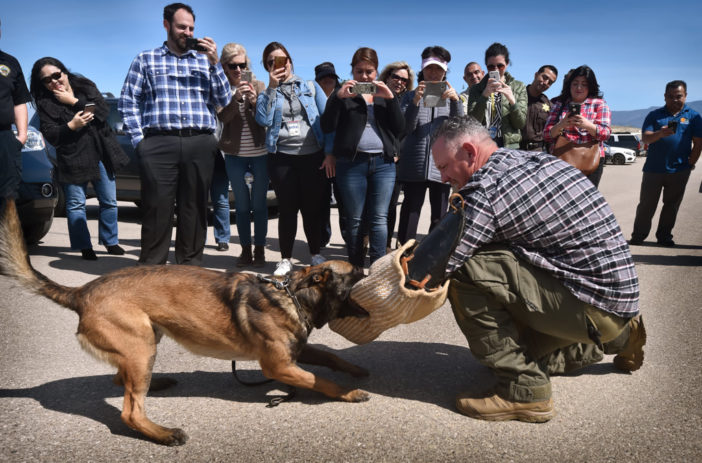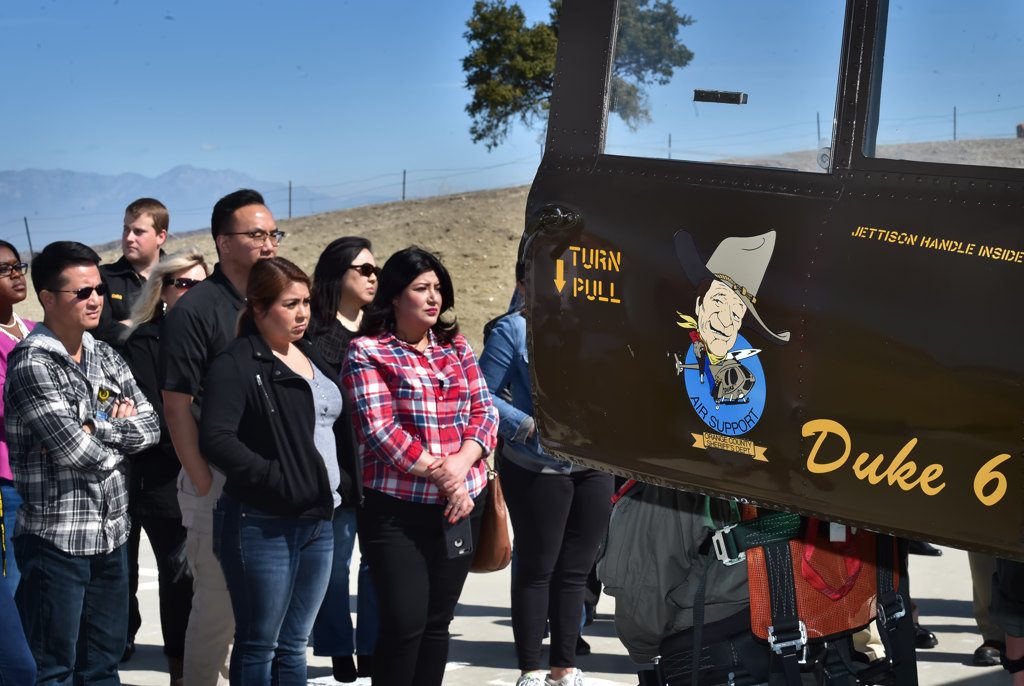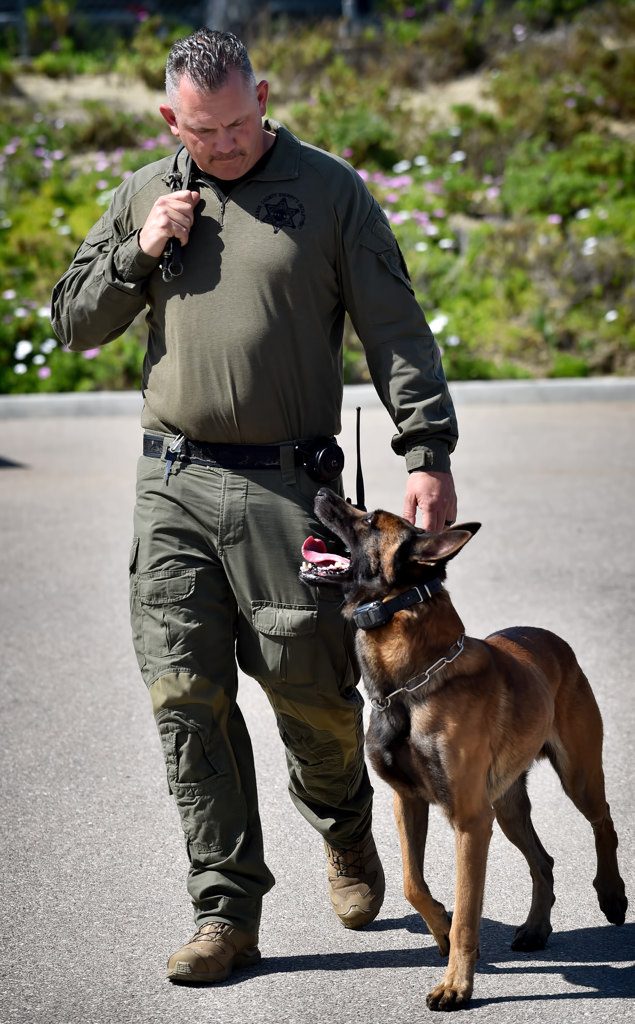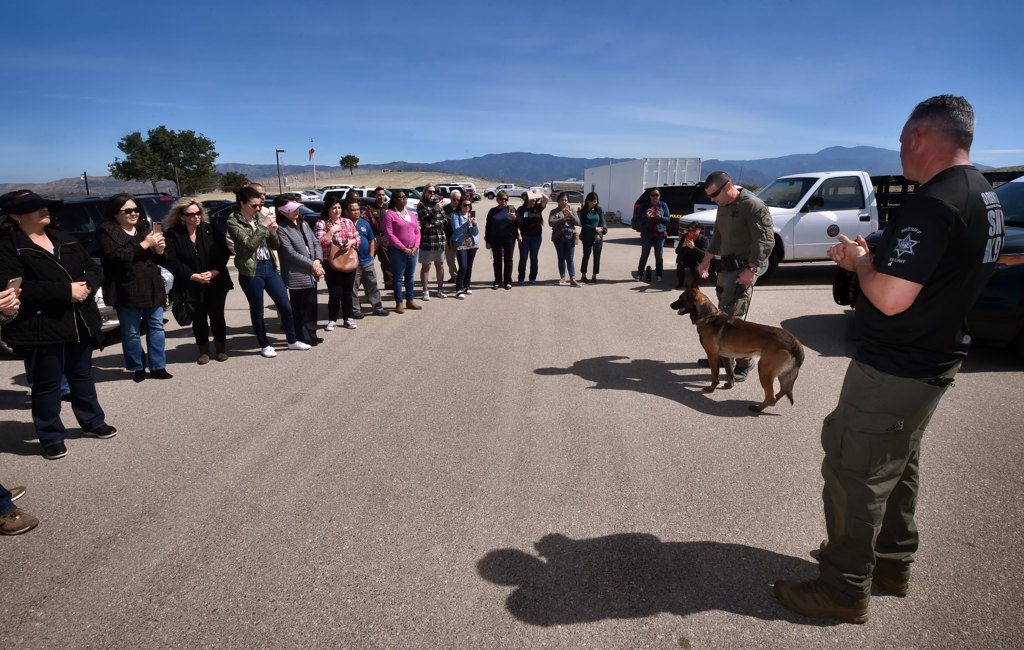This Friday, 28 employees of the Orange County Sheriff’s Department will tour the coroner’s office to get an up-close look at the fascinating — and, for some people — disturbing world of death investigations.
The March 30 field trip will culminate an eight-week, 24-hour OCSD Employee Citizens’ Academy, and also will be the day the group will graduate after getting behind-the-scene looks at various OCSD operations, from the Emergency Communications Bureau on Loma Ridge to the Central Jail complex in Santa Ana to the Tactical Training Center in Orange where advanced officer training is conducted and where the Bomb Squad and SWAT are housed.
Citizens’ academies are common at law enforcement agencies, but not ones reserved for agency employees.

OCSD Air Support Unit personnel (from left) Deputy Joe Kantar, ASU Safety Officer; PSR Bruce Pulgencio, Aviation Support; Deputy Eddie Ochoa, SEB Paramedic; and Deputy Robert Hanvey, ASU Paramedic, talk to OCSD employee academy students about the operation of the Duke 6 search-and-rescue helicopter.
Photo by Steven Georges/Behind the Badge OC
The size of the OCSD (about 3,800 sworn and professional staff members, plus more than 800 reserve personnel) makes it difficult for employees to get exposed to all the inner workings of the department, which has five organizational commands comprised of 21 separate divisions.
So, for this and many other reasons, an employees’ academy makes sense for the OCSD, says Gail Krause, a public affairs manager who runs the program.
“This academy provides our professional staff with a better understanding of our operations,” Krause said. “Our professional staff is the backbone of our department. They provide critical resources and support to our sworn personnel so they can perform their jobs safely and successfully.”
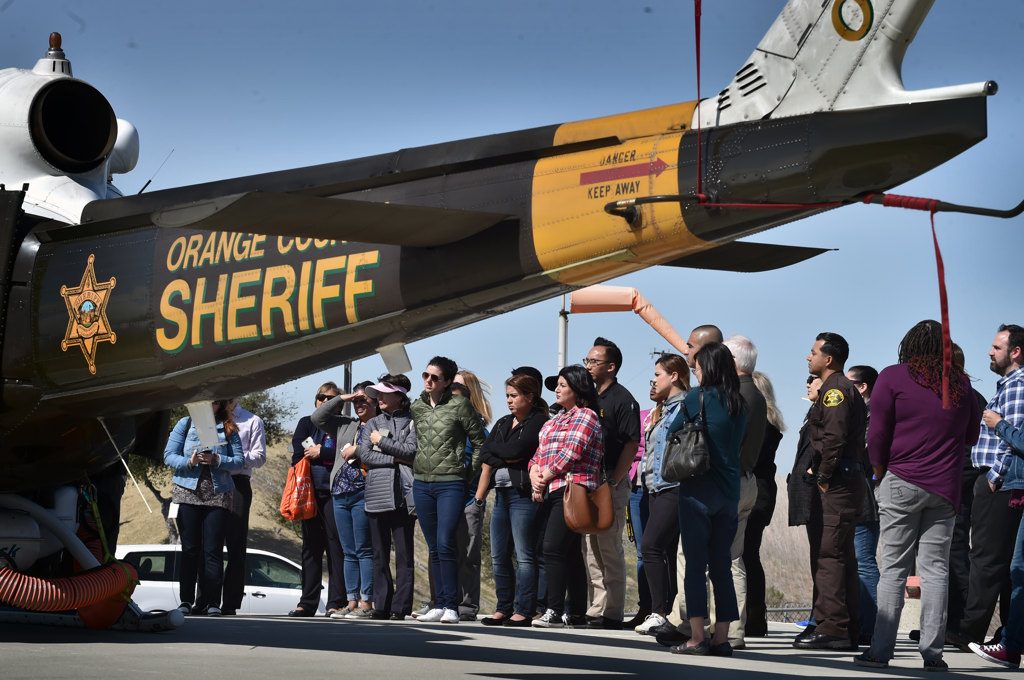
OCSD’s employee academy students gather in front of the Duke 6 search and rescue helicopter at the Loma Ridge heliport.
Photo by Steven Georges/Behind the Badge OC
The current employees’ academy is the sixth for the OCSD. Participants come from within all areas of the OCSD, including budget, courts, jails, communications and technology, the crime lab, criminal investigations, finance, inmate services, support services, training and more.
Academy participant Julio C. Robles, a senior correctional services technician, has been with the OCSD for about 12 years.
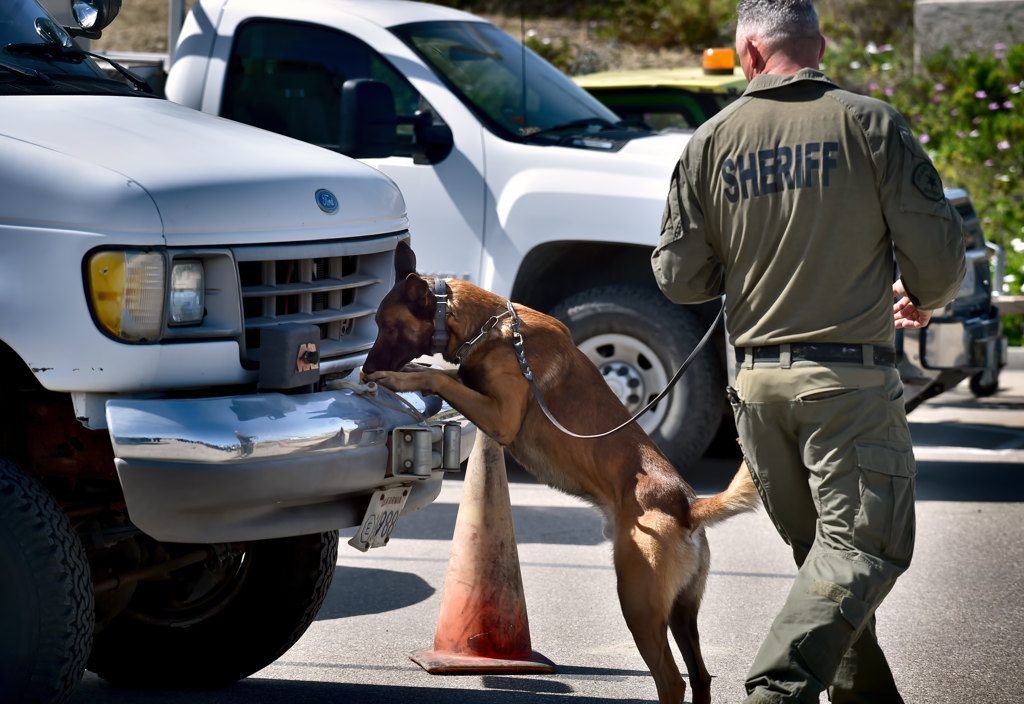
Deputy Gerard McCann walks his K9 partner, Falco, through the parking lot of the Loma Ridge EOC in search of drugs as part of a demonstration for academy students.
Photo by Steven Georges/Behind the Badge OC
“Unless you have a sworn position and get transferred to different assignments as your law enforcement career advances, most individuals will work in the same or a similar work assignment within the same facility for long periods of time,” Robles said.
“I can proudly tell you that now I have seen, lived and experienced much more of our sheriff’s department than most,” Robles added. “I really don’t have enough words to express my gratitude to all individuals involved in making this project a reality.”
On March 9 — week five of the academy — participants visited Loma Ridge, which rises 1,300 feet above Santiago Canyon Road, to learn about the OCSD’s Dispatch and Emergency Communications operations, as well as the Air Support Unit.
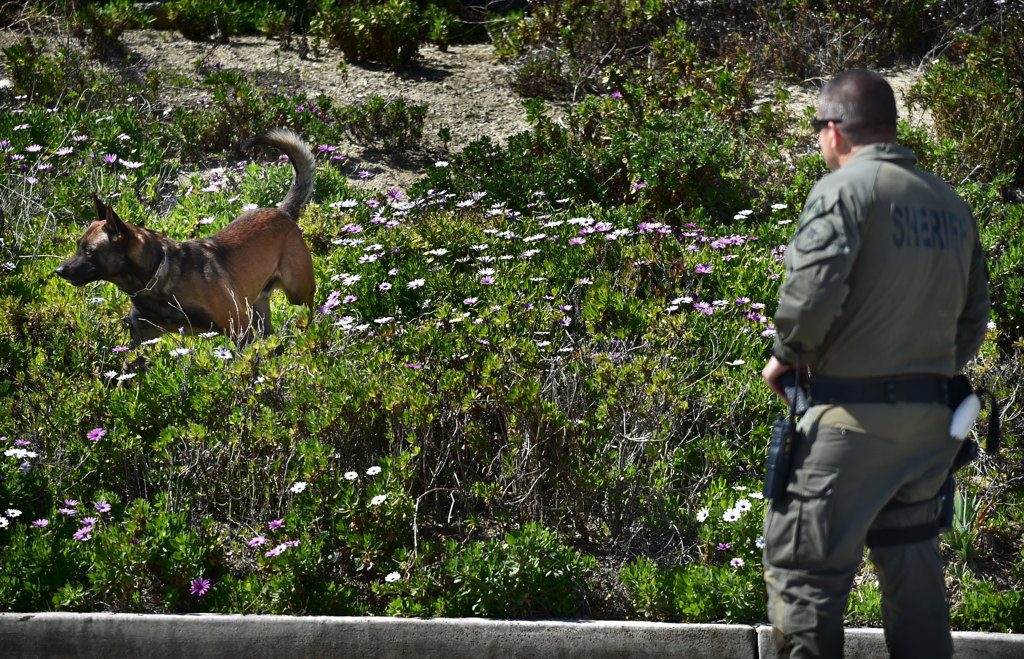
Ketel looks through the brush at the Loma Ridge EOC for a weapon as his K9 handler, Deputy Kent Carpenter, keeps an eye on him during a demonstration.
Photo by Steven Georges/Behind the Badge OC
They also were treated to a K9 demonstration.
The class toured the recently remodeled dispatch center, which now has some natural light coming through the ceiling, and learned how the countywide emergency communications system works.
Dispatchers handle, on average, about 500,000 calls a year, and a dispatcher can be responsible for as many as 50 deputies in the field at any given time, Lt. Gene Inouye, Emergency Communications Bureau commander, told the class.
Sgt. Bill Fitzgerald of the Air Support Unit and four crew members — hoist operator Deputy Joe Kantar, paramedic Deputy Edwin Ochoa, paramedic Deputy Robert Hanvey and pilot PSR Bruce Pulgencio — flew over to Loma Ridge in one of the OCSD’s two Hueys, Duke 6.

OCSD Deputy Kent Carpenter holds up a handgun found in the bushes at the Loma Ridge EOC by his K9 partner, Ketel, during a demonstration of the K9’s powerful scent capabilities.
Photo by Steven Georges/Behind the Badge OC
They talked about aviation search and rescue and showed the class a video of notable rescues and arrests.
Participants then got a chance to see the helicopter up close and learn such things as the maximum weight on the hoist (600 pounds) and how far it can be dropped (250 feet).
Mackenzie Carl, a crime analyst who works in criminal investigations, said the academy is an invaluable experience.

The OCSD’s employee academy students get an up-close look at the Duke 6 search-and-rescue helicopter at the Loma Ridge heliport.
Photo by Steven Georges/Behind the Badge OC
“Each week, I’ve been able to listen and interact with the leaders and experts of (various units) and gain more knowledge, understanding and appreciation for the work that they do on a daily basis,” Carl said.
Robles said his favorite part of the academy was visiting the range at the Katella Tactical Training Center in Orange.
“Every location has many interesting aspects, but I found ‘The Range’ experience to be one of a kind, especially for those civilians not experienced with shooting a firearm and doing it for the first time,” Robles said.
“It was totally unforgettable.”
For Carl, one of her favorite experiences was learning about the Crime Lab and its functions.
“Although I’m in law enforcement, my knowledge of crime labs is mainly biased through what I have seen on TV shows and movies,” Carl said.
“I gained a deeper appreciation for the intensive and detailed scientific work that occurs within that lab, such as fingerprint analysis, toxicology, trace evidence, and crime scene investigation.

Employee academy students and Air Support Unit personnel gather in front of the OCSD’s Duke 6 search-and-rescue helicopter at the Loma Ridge heliport.
Photo by Steven Georges/Behind the Badge OC
“Fingerprint analysis, in particular, was intriguing to me. The analysts must be able to detect patterns and anomalies of one particular print, which I learned is not trivial…TV shows and movies portray this type of work as fast and simple, but I learned that that is not the case and the skill, knowledge, and training for any of those in the crime lab (much like the rest of the Sheriff’s Department) is incredible.”
For Susan Doesburg, an investigative assistant in Southeast Operations and a 24-year veteran of the agency, a highlight was difficult to pick.

OCSD’s Duke 6 search-and-rescue helicopter performs a flyby for the employee academy students before heading back to John Wayne Airport.
Photo by Steven Georges/Behind the Badge OC
“I truly have enjoyed everything,” Doesburg said. “I’ve met a lot of new people I would have otherwise never met. But if I had to choose one thing, I guess it would be getting to detonate a bomb during the Bomb Squad presentation.
“That’s just not something one gets to do every day.”
The academy has inspired Robles, Carl and Doesburg to think more about their career options within the OCSD.
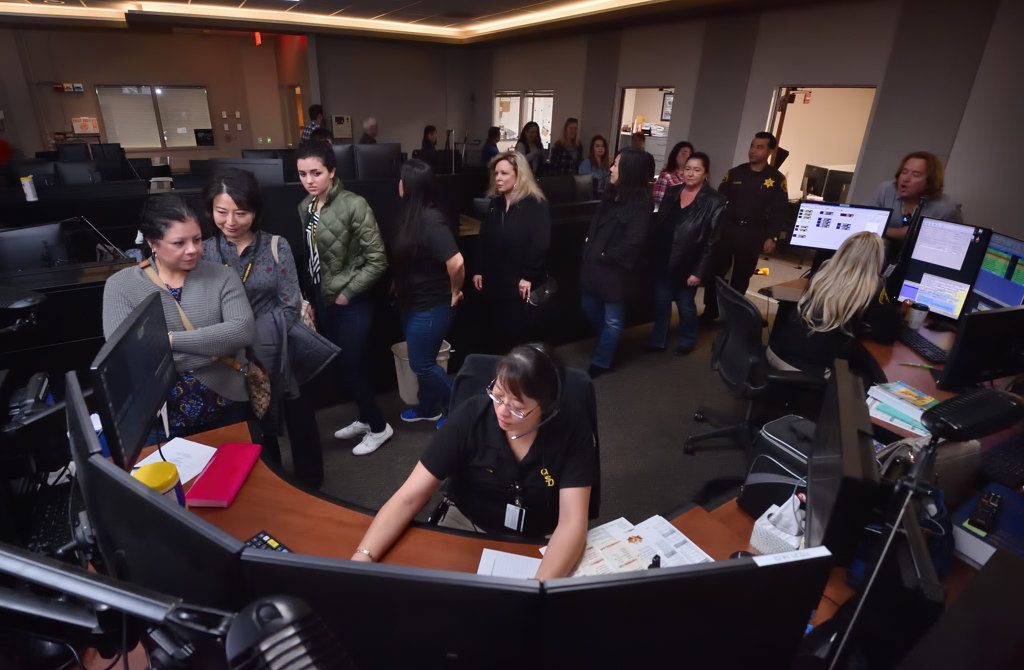
Employee academy students walk through the county’s ECD (Emergency Communications Bureau) 911 center at the Loma Ridge EOC.
Photo by Steven Georges/Behind the Badge OC
“This exposure, and the support to seek a work position or new assignment that challenges our current abilities, inspires us to gain or develop new skills,” Robles said.
Said Carl: “I will take the experiences that I have had through this academy and apply it to my own career at the Sheriff’s Department.”
Undersheriff Don Barnes and various commanders, captains, lieutenants, sergeants, deputies and reserves participated in the academy.
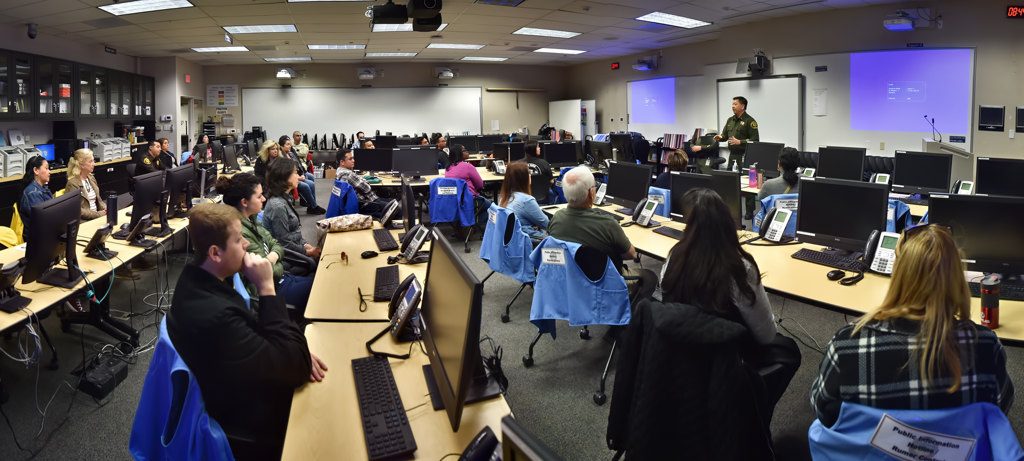
OCSD Lt. Gene Inouye talks to the academy students at the Loma Ridge EOC (Emergency Operations Center).
Photo by Steven Georges/Behind the Badge OC
“They have each gone out of their way to make us feel welcome and stress how important each of us are and how important our role is to the department and its success,” Doesburg said.
“Our class has enjoyed each week so much, we’ve actually stayed longer than the allocated time,” she added. “Most of us (didn’t want) the class to end.”
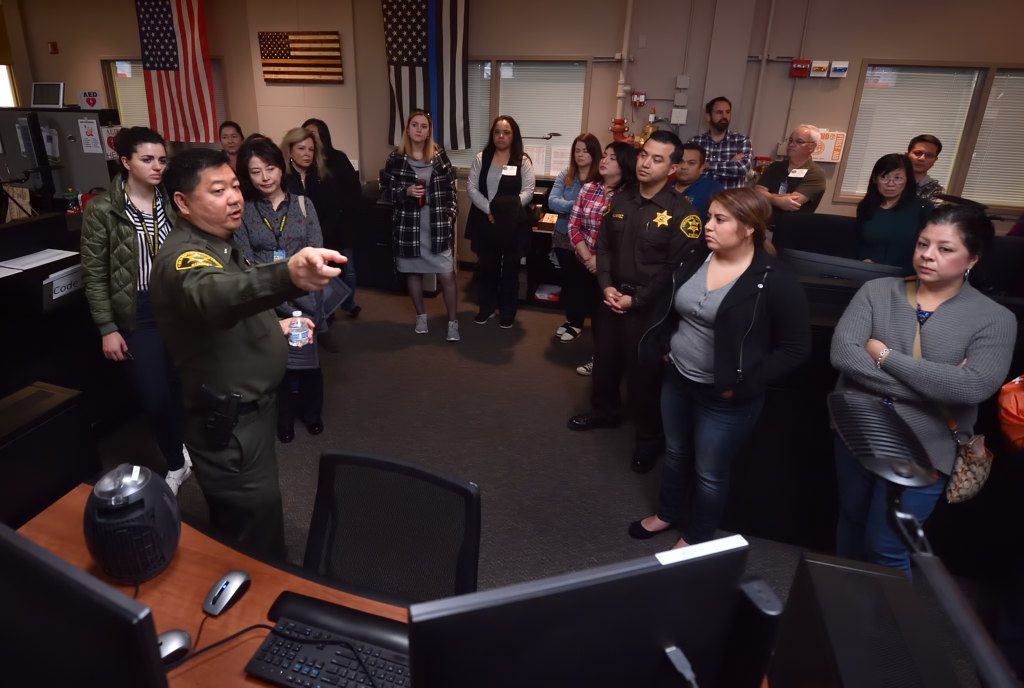
Lt. Gene Inouye leads a group of employee academy students through the county’s ECD (Emergency Communications Bureau) 911 center at the Loma Ridge EOC.
Photo by Steven Georges/Behind the Badge OC

Deputy Kent Carpenter, right, holds onto his K9 partner, Ketel, as he grabs on to Deputy Gerard McCann during a demonstration.
Photo by Steven Georges/Behind the Badge OC
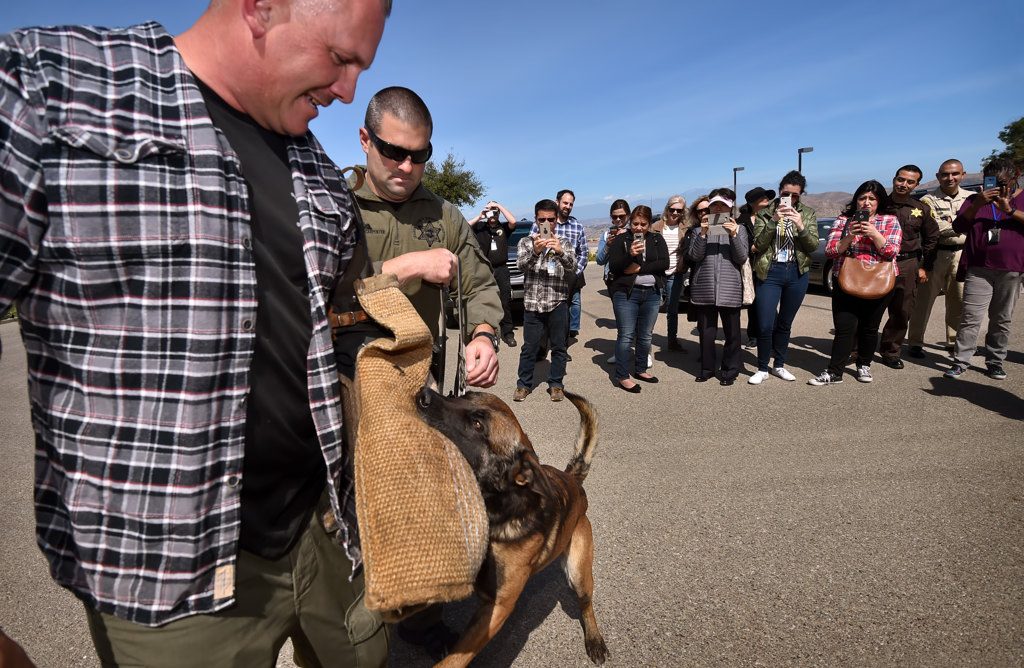
OCSD Deputy Kent Carpenter supervises as his K9 partner, Ketel, grabs onto Deputy Gerard McCann during a demonstration for employee academy students.
Photo by Steven Georges/Behind the Badge OC
 Behind the Badge
Behind the Badge
